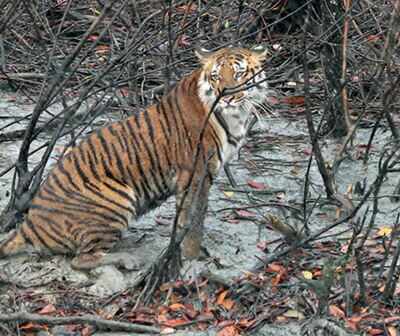
KOLKATA: Indian Sunderbans received a shot in the arm in its fight against climate change. An ecological observatory — the first of its kind in the mangroves — launched in the tiger reserve area on Thursday will help foresters get key information on climate change indicators like water salinity, turbidity and temperature.
State forest minister Bratya Basu inaugurated it on Thursday. State’s chief wildlife warden Ravi Kant Sinha said that while a laboratory space had been allotted on the campus of Sajnekhali forest camp, a mobile data logger to record water salinity and other parameters would be placed in one of the patrolling boats.
“As the boat traverses the creeks, it will keep recording salinity, turbidity and temperature of water,” said Ratul Saha, head of Sunderbans chapter of WWF-India. The project is a joint collaboration of the Bengal forest department, Indian Institutes of Science Education and Research (IISER), WWF-India and Discovery India.
This will entail building datasets on impacts of climate change on the estuarine ecosystem, said WWF-India’s secretary general and CEO, Ravi Singh. Through this project, another observatory with data loggers, monitoring buoys and an on-site laboratory will be set up in the South 24 Parganas forest division.
“While the data logger will give instant data on water’s oxygen, salinity and pH levels, samples collected will be tested at the lab to unearth the biological indicators of the water, including the status of micro planktons. The move is aimed at understanding the links between nutrient availability, salinity and bio-indicators to get an overview of the entire ecosystem,” added Saha.
Recently, of the 12 species that the National Geographic had highlighted in one of its volumes on climate change, the Sunderbans tiger had been listed as one that will struggle. The report had referred to an earlier study in Bangladesh Sunderbans that had predicted that with a 28-cm sea level rise from the year 2000, the remaining tiger habitat in the Bangladesh swamp would decline by 96%.
An earlier study on evolution of mangrove plants in Indian Sunderbans by city-based NGO Nature Environment and Wildlife Society in association with forest department had indicated that water salinity was higher in forests of Pirkhali, Dhulibashani and Ajmalmari while it was found to be low in Bagmara and Netidhopani.
Among the other launches in the Sunderbans on Thursday was the replacement of a floating camp — a vessel with forest guards that keep eye on the mangroves — at the Sarakkhali area in the tourism zone and a speed boat for South 24 Parganas division. WWF-India also handed over nylon nets, which would cover an area of up to 10 kilometres, for use in the same division to check incidents of tiger straying. The tiger population in the mangroves has grown in 2018 mainly on the back of a rise in big cat number outside the reserve area.
State forest minister Bratya Basu inaugurated it on Thursday. State’s chief wildlife warden Ravi Kant Sinha said that while a laboratory space had been allotted on the campus of Sajnekhali forest camp, a mobile data logger to record water salinity and other parameters would be placed in one of the patrolling boats.
“As the boat traverses the creeks, it will keep recording salinity, turbidity and temperature of water,” said Ratul Saha, head of Sunderbans chapter of WWF-India. The project is a joint collaboration of the Bengal forest department, Indian Institutes of Science Education and Research (IISER), WWF-India and Discovery India.
This will entail building datasets on impacts of climate change on the estuarine ecosystem, said WWF-India’s secretary general and CEO, Ravi Singh. Through this project, another observatory with data loggers, monitoring buoys and an on-site laboratory will be set up in the South 24 Parganas forest division.
“While the data logger will give instant data on water’s oxygen, salinity and pH levels, samples collected will be tested at the lab to unearth the biological indicators of the water, including the status of micro planktons. The move is aimed at understanding the links between nutrient availability, salinity and bio-indicators to get an overview of the entire ecosystem,” added Saha.
Recently, of the 12 species that the National Geographic had highlighted in one of its volumes on climate change, the Sunderbans tiger had been listed as one that will struggle. The report had referred to an earlier study in Bangladesh Sunderbans that had predicted that with a 28-cm sea level rise from the year 2000, the remaining tiger habitat in the Bangladesh swamp would decline by 96%.
An earlier study on evolution of mangrove plants in Indian Sunderbans by city-based NGO Nature Environment and Wildlife Society in association with forest department had indicated that water salinity was higher in forests of Pirkhali, Dhulibashani and Ajmalmari while it was found to be low in Bagmara and Netidhopani.
Among the other launches in the Sunderbans on Thursday was the replacement of a floating camp — a vessel with forest guards that keep eye on the mangroves — at the Sarakkhali area in the tourism zone and a speed boat for South 24 Parganas division. WWF-India also handed over nylon nets, which would cover an area of up to 10 kilometres, for use in the same division to check incidents of tiger straying. The tiger population in the mangroves has grown in 2018 mainly on the back of a rise in big cat number outside the reserve area.
Trending Topics
LATEST VIDEOS
City
 Shocking! 14-year-old girl raped by 3 men over 3 days in Gurugram, Delhi
Shocking! 14-year-old girl raped by 3 men over 3 days in Gurugram, Delhi  Kerala flood: Red alert issued in 4 districts, flight operations at Kochi airport suspended till Sunday 3pm
Kerala flood: Red alert issued in 4 districts, flight operations at Kochi airport suspended till Sunday 3pm  SAIL chief brutally attacked by goons with iron rods and knives on south Delhi road
SAIL chief brutally attacked by goons with iron rods and knives on south Delhi road  Air coolers, fans installed in Siliguri’s zoo to help inmates beat the heat
Air coolers, fans installed in Siliguri’s zoo to help inmates beat the heat
More from TOI
Navbharat Times
Featured Today in Travel
Quick Links
Lok Sabha Election Schedule 2019Lok Sabha Election NewsDelhi Capitals teamMI team 2019Rajasthan Royals 2019RCB team 2019Maharashtra Lok Sabha ConstituenciesBJP Candidate ListBJP List 2019 TamilnaduShiv Sena List 2019AP BJP List 2019Mamata BanerjeeBJP List 2019 MaharashtraPriyanka GandhiBJP List 2019 KarnatakaAMMK Candidate List 2019BJP List 2019 WBLok Sabha Elections in Tamil NaduBSP List 2019 UPNews in TamilLok Sabha Poll 2019Satta Matka 2018PM ModiMahagathbandhanNagpur BJP Candidate ListChandrababu NaiduTamil Nadu ElectionsUrmila MatondkarNews in TeluguMadras High CourtTejashwi YadavArvind KejriwalTejasvi SuryaPawan KalyanArvind KejriwalYogi AdityanathJaya PradaSatta King 2019Srinagar encounter
Get the app




